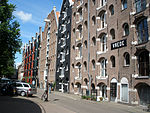Houthaven

Houthaven is a neighbourhood of Amsterdam, Netherlands situated in the West borough. Literally meaning "lumber port", Houthaven is a port situated along the IJ in Amsterdam's western port. It is bordered by a dam in the IJ river to the north and the Spaarndammerbuurt in the south. It is currently predominantly used by inland barges, however plans are in motion to radically change the area in the next few years by building a new residential area on seven artificial islands. The harbour is made up out of four parts (from east to west): Oude Houthaven (Old Lumber Port), Houthaven, Nieuwe Houthaven (New Lumber Port) and Minervahaven (Minerva Port). This is why the Houthaven is also referred to as the Houthavens (which is the plural).
Excerpt from the Wikipedia article Houthaven (License: CC BY-SA 3.0, Authors, Images).Houthaven
Haparandadam, Amsterdam
Geographical coordinates (GPS) Address Nearby Places Show on map
Geographical coordinates (GPS)
| Latitude | Longitude |
|---|---|
| N 52.397222222222 ° | E 4.8819444444444 ° |
Address
Haparandasteiger
Haparandadam
1013 AK Amsterdam
North Holland, Netherlands
Open on Google Maps










